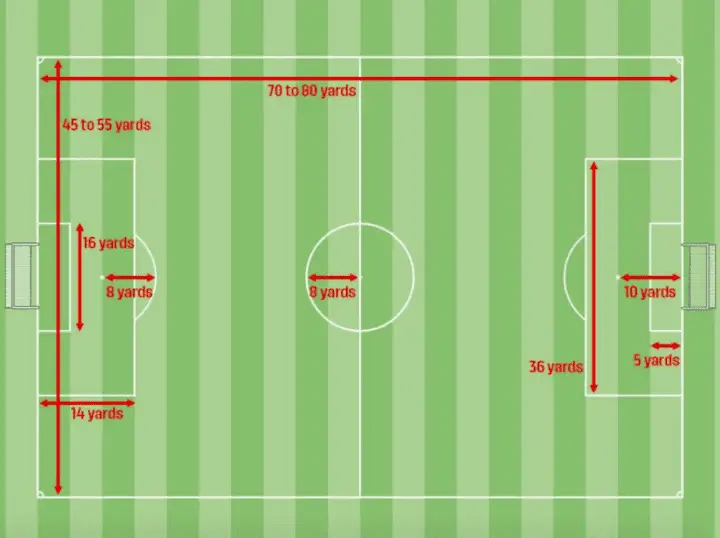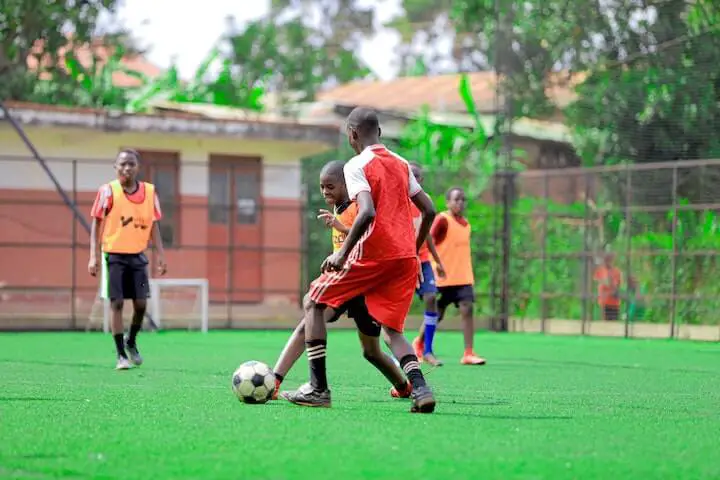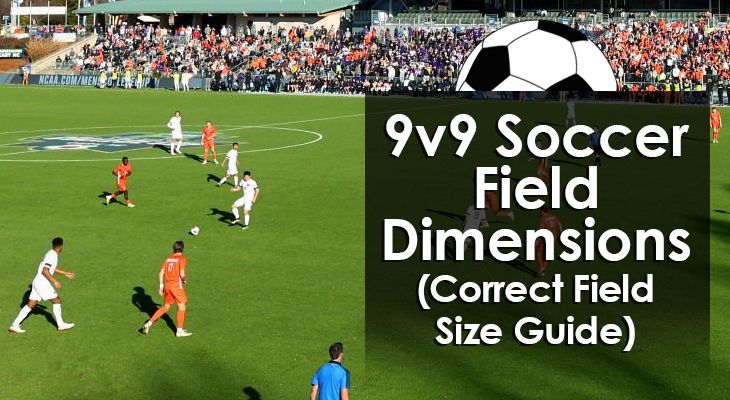9v9 Soccer Field Dimensions (Correct Field Size Guide)
9v9 soccer games are predominantly played by U11 and U12 youth teams, right before they make the switch to 11v11 on a full-size field.
Since there are fewer players competing on the pitch, 9v9 soccer field dimensions are a little smaller than the regulation size.
With less room, players must rely on their fundamentals and coaching to find success.
This guide breaks down the correct 9v9 soccer field dimensions to use.
If you’re a youth coach or want to get involved in grassroots soccer, use it as a tool to come up with formations and tactics, and to get a better idea of where you can create space on the field.
9v9 Soccer Field Dimensions: Overview

Image from U.S. Youth Soccer
U.S. Youth Soccer liaises with state soccer associations to optimize and improve the development of the sport around the country.
Depending on the age group, there are specific recommendations about how to play.
These guidelines include things like soccer field dimensions, offside rules, minutes allocations, and training schedules.
The U.S Youth Soccer player development strategy helps ensure all participants have equal opportunities and can train and take part in an encouraging and skill-based environment.
Although there are games and tournaments, these guidelines encourage coaches to place emphasis on growth and improvement, rather than winning.
One of the most important directives that drives youth development in the U.S. is providing age-appropriate playing conditions, in which field dimensions play a major role.
9v9 Soccer Field Dimensions:
The U.S. Youth Soccer laws of the game outline recommended field dimensions for 9v9 games.
Here are the optimal conditions for your U11 and U12 youth team to play in:
- Field Length: 70 to 80 yards
- Field Width: 45 to 55 yards
- Penalty Box: 14 yards long and 36 yards wide
- Goalkeeper Area: 5 yards long and 16 yards wide
- Penalty Spot: 10 yards from the goal line
- Center Circle: 8-yard radius
- Goal Frame: Maximum of 7 feet high and 21 feet wide
All line markings should be the same width (5 inches or less) to create a uniform outline.
One of the major changes from U9 and U10 to U11 and U12 is the removal of build out lines.
Although there are offsides in 9v9 games, players aren’t restricted by build out rules and lines.
Coaches and players here have the freedom to play how they wish, even if that involves long ball tactics from goal kicks.

9v9 Soccer Field Length
A 9v9 soccer field should be between 70 - 80 yards long.
The leniency is there to ensure teams with limited space or multiple fields can meet regulations.
Many teams use the range to their advantage, choosing a size that suits their playing style.
Since a full-size field is between 98 and 131 yards long, bigger 9v9 soccer field dimensions can help your team prepare for the transition when they reach the U13 age group.
Inversely, if you have a small or defense-minded group, it can be more beneficial to create as small a field as possible.
The markings that run the length of the field are what's known as sidelines or touchlines.
9v9 Soccer Field Width
9v9 soccer fields should be between 45 and 55 yards wide.
Since professional-level fields can be anywhere from 49 to 98 yards wide, some 9v9 pitches are as wide as 11v11 grounds.
However, pro clubs typically create field widths between 70 and 98 yards.
In 9v9 games, the field must have three lines spanning the entire width: one on each end (end lines) and one marking the halfway point (halfway line).
These cross-field lines meet the sidelines to create the full playing area.
9v9 Soccer Field Penalty Box
Each soccer field must have two penalty boxes, one on either end, with the boxes scaled down to an appropriate size for a 9v9 game.
The penalty box should be 14 yards long and 36 yards wide, with the penalty spot marking located centrally, precisely 10 yards from the goal line.
Another important area is the “6-yard box”, which extends outward from the goal line.
On a full-size field, this box is 6 yards long and 20 yards wide.
However, on a 9v9 field, the goal area should measure 5 yards long and 16 yards wide.
9v9 Soccer Field Goal Frame
The goal frame should be no higher than 7 feet and no wider than 21 feet.
U.S. Youth Soccer recommends erecting a goal frame that’s 6.5 feet high and 18.5 feet wide, based on the age and abilities of U11 and U12 players.
A full-size, professional goal frame is 8 feet high and 24 feet wide.
Other Important Markings:
There are three more important markings that every soccer field must have:
a. Center Circle
This area outlines the very center of the field and shows the minimum distance that opposition players must take during kick-off or restarts.
For 9v9 games, the circle radius is 8 yards.
b. Penalty Arcs
These are semi-circles positioned on the edge of the penalty box.
During penalties, all players must remain outside the arc until after the shot.
The radius should be 8 yards from the penalty spot.
c. Corner Areas
A quarter circle with a radius of 1 yard indicates where the players can position the ball during a corner kick, with the center point being the corner of the field.

Conclusion
It’s important to note that some state associations may have their own regulations regarding field dimensions, so be sure to check with your local regulatory body before lining your grounds.
9v9 games are the final stepping stone before players move on to full-size fields.
Therefore, it’s crucial to optimize playing conditions to ensure they reap the benefits of a scaled-down match.
Follow our 9v9 soccer field dimensions guide and consult with your state soccer association to make sure your grounds are in tip-top condition.
We base our guidelines on U.S. Youth Soccer recommendations to make sure our readers avail of high-quality information.

